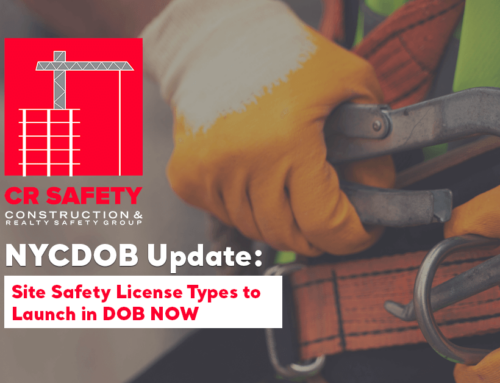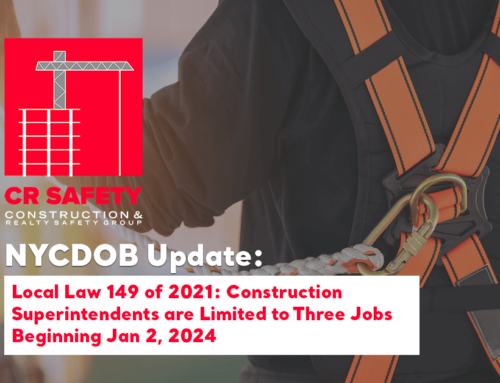By Matt Caruso – President, Construction Realty Safety Group
For owners of buildings in New York City that have not yet been issued a final Certificate of Occupancy (CO), obtaining a Temporary Certificate of Occupancy (TCO) is paramount to beginning and continuing their building operations. Between the extensive review process and, more recently, the bifurcation of the Building Information System (BIS) and DOB NOW, extensive follow-up and an intimate knowledge of the process is required to meet TCO goals. This makes the role of filing rep a critical one.
The first step in obtaining a TCO is submitting the application package to a project advocate for review. During this process, based on their individual experience level, the project advocate will request varying levels of clarification from the filing rep. Therefore, it is important to include a robust application package with a CO checklist to help project advocates find their requested points of clarification with ease and without the need for producing further materials. As this initial phase occurs through the portal on DOB NOW, it is important to keep in mind that the project advocate may not put their name on the application, and that even if they do, an email will not be provided. This is where filing reps having previous correspondence with senior project advocates can work to their clients benefit.
As a TCO is being reviewed, the project advocate may require the filing rep to change the status of the building to indicate occupancy during ongoing work. This is also where challenges from the bifurcation of BIS and DOB NOW presents itself. As the project advocate and filing rep review points of clarification, Post Approval Amendments (PAA’s) are made to the Schedule A displayed on BIS, which then have to be applied through DOB NOW as a correction to the Building Schedule of Occupancy (BSO).
Upon all inquiries being addressed and the Schedule A and BSO lining up, the project advocate submits the updated application package to the borough commissioner or deputy borough commissioner for review. Turnaround after submission to the commissioner or deputy commissioner can vary based on the borough but typically results in an approval and submission of the application to quality assurance before final issuance of the TCO. Objections from quality assurance are even rarer but result in the package being returned to the initial project advocate.
Obtaining a TCO or TCO renewal can seem like a challenge but with careful preparation and understanding of all steps involved it can be a smooth process. Having a reliable filing rep on the project, that knows each phase of the process, allows owners the peace of mind that their building’s TCO can be obtained on time or ahead of schedule.
DOB NOW Filing Challenges & Solutions
Obtaining a permit from the New York City Department of Buildings (DOB) involves an array of challenges based on the specific project scope to the coordination of required forms between different entities to unforeseen project delays. Historically, the role of the project filing rep has been to serve as the central point of contact between all involved parties, with the full ability to proactively work with the DOB and account for these obstacles. As procedures have changed, filing responsibilities are now divided between as many as five entities, creating a need for increased project coordination.
The completion of required forms once fell only to the filing rep, in coordination with their client and all relevant applicants of record (AoR’s). This responsibility, once carried out by a single individual, on behalf of the other parties involved, is now divided amongst the filing rep, owner, relevant AoR’s, third party special inspectors and the general contractor. In addition, for each filing type, the DOB system filing requirements have recently began evolving more rapidly, requesting more specific information for each work scope. This new, more dynamic system presents a need for increased cooperation and followup to ensure all members of a project team are on the same page in achieving their common objective. With this in mind, open communication between the entire project team, with the filing rep as the “quarterback” can be integral in meeting or exceeding a set filing timeline to meet permitting goals. By coordinating throughout the entirety of the process, final signoffs from the filing rep, AoR’s, special inspectors, general contractor and property owner can occur as smoothly as possible. This coordination will ultimately save time that is invaluable to owners and developers looking to obtain critical permits for their projects.
Matt Caruso is the President of Construction Realty Safety Group. Matt oversees the company’s operations and development. Matt is responsible for overseeing all project management and contract administration, financial oversight, development and implementation of new policies and procedures.
A Full-Service Safety Management Firm
CR SAFETY offers full-service construction safety solutions, including on-site, professional safety management staffing, complete and customized Plan Program Development, and all required safety training.
Receive Our Updates in Your Inbox!
Site Safety Management Solutions
CR Safety offers the appropriate certified professionals to effectively manage safety on a technical and administrative level. Information is transmitted via daily logs, deficiency notices, recommendation logs, safety alerts, safety meetings and accident reports, all sent electronically.
Site Safety Plans and Programs
Whether it’s the Chapter 33 requirement of the NYC Building Code or OSHA 1926 requirements, CR Safety can develop the most efficient site safety plans & programs for your project. Read more about our site safety plans and programs…






